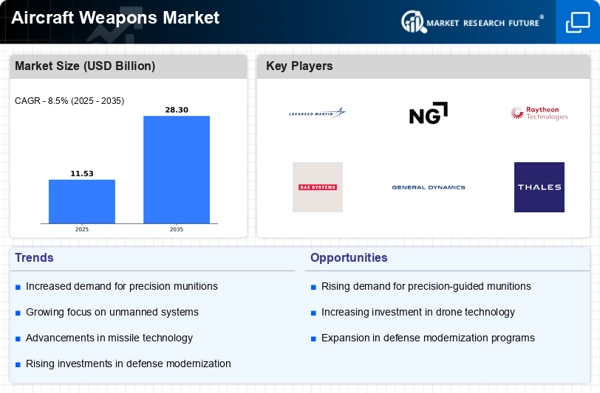Technological Innovations
Technological innovations play a pivotal role in shaping the Aircraft Weapons Market. The integration of cutting-edge technologies such as artificial intelligence, advanced materials, and precision-guided munitions is transforming the landscape of military aviation. For example, the development of hypersonic weapons and next-generation missile systems is expected to redefine aerial combat strategies. The market for smart weapons, which are designed to enhance accuracy and reduce collateral damage, is projected to grow substantially, with estimates suggesting a compound annual growth rate of over 5% in the coming years. These advancements not only improve the effectiveness of aircraft weapons but also drive competition among defense contractors, further stimulating the Aircraft Weapons Market.
Rising Geopolitical Tensions
The Aircraft Weapons Market appears to be significantly influenced by rising geopolitical tensions across various regions. Nations are increasingly investing in advanced military capabilities to deter potential threats. For instance, defense budgets have seen a marked increase, with some countries allocating over 2% of their GDP to military expenditures. This trend suggests a growing recognition of the need for robust defense systems, including advanced aircraft weapons. As nations seek to enhance their deterrence capabilities, the demand for sophisticated weaponry is likely to rise, thereby propelling the Aircraft Weapons Market forward. Furthermore, the ongoing conflicts in various regions may further exacerbate this demand, as countries strive to modernize their fleets and ensure operational readiness.
Growing Demand for Air Superiority
The growing demand for air superiority is a critical driver of the Aircraft Weapons Market. Nations are increasingly aware of the strategic importance of maintaining control of the skies in modern warfare. This realization has led to substantial investments in advanced aircraft and weapon systems designed to achieve air dominance. The market for air-to-air missiles and advanced fighter jets is expected to expand, with projections indicating a growth rate of approximately 6% over the next decade. As countries seek to enhance their aerial capabilities, the Aircraft Weapons Market is likely to benefit from this focus on air superiority, leading to increased procurement of advanced weaponry and systems.
Increased Focus on Modernization Programs
The Aircraft Weapons Market is witnessing a surge in modernization programs as nations strive to upgrade their aging military fleets. Many countries are investing heavily in the refurbishment and enhancement of existing aircraft, which includes the integration of advanced weapon systems. Reports indicate that defense spending on modernization initiatives could reach upwards of $100 billion annually in the next few years. This trend is particularly evident in nations with older aircraft models that require significant upgrades to maintain operational effectiveness. As these modernization efforts unfold, the demand for advanced aircraft weapons is likely to increase, thereby providing a substantial boost to the Aircraft Weapons Market.
Emergence of Unmanned Aerial Vehicles (UAVs)
The emergence of unmanned aerial vehicles (UAVs) is reshaping the Aircraft Weapons Market in profound ways. UAVs are increasingly being equipped with advanced weaponry, allowing for precision strikes without risking pilot lives. The market for armed drones is projected to grow significantly, with estimates suggesting a potential increase of over 15% annually. This growth is driven by the increasing adoption of UAVs for surveillance, reconnaissance, and combat missions. As military forces recognize the strategic advantages offered by UAVs, the demand for associated weapon systems is likely to rise, thereby enhancing the overall Aircraft Weapons Market. The integration of UAVs into existing military frameworks is expected to create new opportunities for innovation and development.


















Leave a Comment